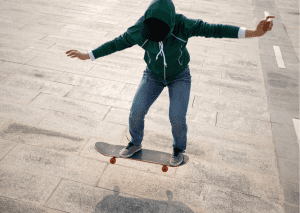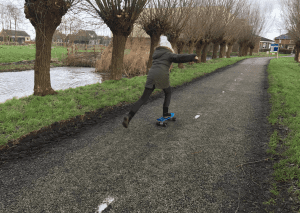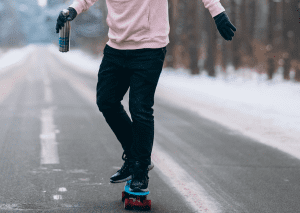Safe skateboarding isn’t limited to summer. Enjoying this sport during the winter weather is possible, but it’s crucial to take extra precautions to secure your ride.

Everyone knows that good skateboarding should be fun and enjoyable experience for everyone, whether it’s their first time skateboarding or they’re seasoned in the sport, even in winter conditions.
- This article will cover practical skateboard tips on how to dress appropriately for the cold weather, prepare your skateboard for cold weather, master skateboard riding techniques for slick surfaces, understand how cold weather affects skateboard rides, stay safe on winter roads, and prioritize recovery and self-care.
- From wind protection to cold winter skateboarding challenges, these insights ensure a smooth skateboard ride for skateboarders in all type of weather.
- When maneuvering your skateboards in cold weather, it is important to dress appropriately in layers, waterproof gear, and warm footwear.
It is also important to understand how to master techniques for navigating slick surfaces, such as ice, snow, and rain-slick surfaces. Lastly, it is essential to prioritize recovery and self-care to avoid overexertion and injuries.
Embracing the winter skateboarding experience, with no sweat, requires a combination of preparation, skill development, and a passion for conquering the unique challenges that come with colder conditions.
Key Takeaways
Let’s not shy away from embracing the winter breeze, but let’s do it without harming ourselves! To do this, prepping your board and understanding how the cold affects your ride is essential.
- To stay safe and keep shredding, check the weather for your area, dress appropriately, and use protective gear for skateboarding when necessary.
- Additionally, ensure your skateboard has a proper skateboard grip, take extra caution on slick surfaces, and practice skateboard self-care and recovery.
- Skateboarding is a distinctive aspect of sports and recreation, so it’s essential to recognize that mastering skateboard techniques for slippery surfaces and being mindful of road rules during cold weather are crucial elements for maneuvering skateboards in cold weather.
Appropriate Clothing For The Winter Time
Don’t underestimate the power of wearing the right clothes when riding in the cold; your choice of gear can make or break your cold-temperature ride! As riders, ensuring that our bodies are adequately covered not only contributes to comfort but also shields our skin from the harsh elements. So wear your long sleeve clothing and take note of these:
- In cold weather or temperatures, the benefits of wearing thick thermal underwear are immense, providing warmth while allowing for mobility. Equally vital is waterproof footwear, protecting our feet from icy terrains when skateboard riding.
- As skateboarders, particularly when braving the cold weather, we must be safe and comfortable during cold weather. Avoid skating in the cold without proper protective skateboard gear.
- Proper skateboard attire, encompassing essentials like skateboard helmets, skateboard wrist guards, skateboard socks, and skateboard long sleeves, and choosing the right temperature for skateboarding, plays a pivotal role in ensuring a successful and secure skateboard experience, even when the skate park is blanketed in snow.
- It’s a good idea to dress to retain body heat while skateboarding in cold weathers.

It’s important to remember that proper preparation is key to a successful skateboarding experience. In a chilly season, a long sleeve would protect you from the cool breeze. Find one that suits you, as there are many places you can shop from.
Make sure to dress appropriately for the cold season, equip your skateboard with the right parts, and consider accessories that provide additional support for your joints. This ensures that you have the best time possible while securing your comfort and well-being during your skateboarding sessions, of course.
Skateboard Preparation During Winter Season
Everyone knows and understands that maintenance and winter upgrades are essential for a safe ride and the longevity of equipment. Before you go out, it’s important to winterize your board to keep it in prime condition despite cold temperatures. Don’t skip out on this! Keeping it in top shape is essential for your welfare. You have to check it every year, especially before winter!
Here are some tips to help you get started:
- For added safety, swap your skateboard bearings with ones specifically designed for cold weather.
- Use a softer skateboard wheel durometer for better traction and grip.
- Apply a water-repellent finish to protect the skateboard from snow and rain.
Master Slick Surfaces Outdoor
Mastering slick surfaces can truly test your grit, but it’s an exhilarating challenge you’ll conquer with the right techniques. Whether it’s through slip prevention or perfecting ice trick moves, we ride not just for fun, but also to help each other navigate these cold temperature hurdles.
Learning to adapt to icy conditions enhances your skills, allowing you to confidently tackle skating in cold weather and explore other tricks unique to the frosty environment. While skating in cold presents its own set of challenges, it ultimately improves your overall abilities, making you a more versatile skater.
We can now better understand how skating in cold weather affects our performance overall, and how these skills can transfer back to warm weather conditions, providing a well-rounded skating experience.
The Effect Of Winter On Your Board
People are aware of the importance of harm-free performance, especially during a cold temperature. It’s crucial to understand how cold temperatures can affect your performance, and we’re here to shed some light on this often-overlooked aspect. This guide we have prepared for you helps you gain a new understanding and a better idea of how you can take care of your board. During the winter season, sometimes you want to stay at home, but other times you want to go out and ride.
When that happens, of course, you need a sturdy board to use. So when winter is drawing close, slowly prepare your board.

- The cold weather can have a major impact on skateboard riding, including stiffened muscles, skateboard damage due to brittle materials, balance issues from shivering and numbness, and decreased precision when executing stunts.
- Understanding the impact of cold weather on tricks, including reduced skateboard maneuverability and less traction, and preventing cold-induced skateboard damage is crucial for successful skateboarding. Moreover, it’s essential to consider road conditions during cold weather.
- Skateboarders should grasp the effects of cold temperatures on their sport and ensure they have the necessary skateboard gear to stay safe and comfortable while enjoying their skateboards and practicing new tricks in the cold weather.
Stay Attentive On The Roads During Winter Days
As we brace ourselves for the winter months, we must discuss how to stay harmless while riding your board on snow and ice-covered roads. Road safety is an important part. Understanding these best measures can make a huge difference.
- It’s all about enhancing our visibility in these conditions and learning effective ways to share the road with winter vehicles.
- Get to know the key points to ensure every skateboard ride remains an exhilarating experience while being safe.
Skateboard And Snow Visibility
Snow’s glare can be a significant issue, especially during early morning rides, so it’s essential to wear shades or goggles. We recommend snow reflective goggles, which are designed to enhance vision in snowy conditions. For a much harmless ride, anti-fog solutions are available to keep lenses clear during cold days.
- It’s important to remember that winter vehicles must also coexist and cooperate with skateboarders on frosty roads.
- The overall visibility of skateboards in snow and ice is important. From the right eyewear to the right skateboard gear, the key is to wear or use equipment that’s designed to keep you safe and improve visibility in these conditions.
Furthermore, the right skateboard accessories, such as reflectors, lights, and reflective decals, can help enhance visibility in winter conditions.
Other Vehicles During Winter
Navigating icy roads alongside winter vehicles, especially in big cities, can be tricky. Remember your winter etiquette: always maintain a good distance and use vehicle awareness to anticipate your moves.
- It’s all about serving our community by prioritizing road awareness, so let’s make sure we have a good time skating while also showing respect to other road users.
- Done right, it will give us peace of mind for the next section, prioritizing recovery and self-care after a chilly ride.
- No matter the type of board you are riding, it is crucial to be mindful of road etiquette when sharing the road with winter vehicles.
- You can practice skateboard etiquette by giving others plenty of space and using vehicle awareness to anticipate their movements.
By being proactive in your consideration of others, you can help ensure a safe and enjoyable skating experience, even in the winter when there may be fewer people on the roads.
Prioritize Safety
After a cold temperature ride, it’s essential to focus on recovery and self-care for your overall well-being. Let’s explore some tips you can follow.

- Firstly, proper hydration is key. Make sure to drink plenty of fluids to replenish lost electrolytes. Bringing your water bottles is a good idea.
- Secondly, warm up your muscles before skating again to avoid any skateboard injuries.
- Thirdly, ensure you get adequate rest for full body recovery.
- Lastly, if you experience any persistent pain, it’s best to seek professional help. After all, if you love skating, it should go hand in hand with taking care of your body, ensuring that you maintain your health and withstand the physical demands of your skateboarding sessions.
Whether you’re skating in cold weather or enjoying warm weather rides, it’s crucial to listen to your body. Skating in cold can sometimes lead to stiffness or discomfort, so proper warm-up routines and protective gear are essential. By taking these precautions, you can continue to enjoy skateboarding in any condition, from skating in cold weather to basking in the sun during warm weather sessions.
Remember, taking care of yourself is the best way to take care of others! By prioritizing recovery and self-care, you’ll be able to maximize your skate session and stay safe. After all, not everyone can perform at their best without proper rest and self-care.
- Do remember that skating indoors is your best bet when conditions take a turn for the worse. Seek out a dry spot like an indoor local skatepark or covered parking lot to keep the fun rolling even on bitterly cold or rainy days.
Skateboarding indoors, especially at indoor skateparks, offers a comfortable and safe environment, shielding you from slippery surfaces and challenges associated with external conditions.
Conclusion
You’ve learned some valuable tips for cold temperatures, such as staying warm, preparing your board, honing slick surface skills, recognizing the impact of cold on your ride, and road etiquette.
- Skateboarding is a distinctive pursuit within the realm of sports and recreation. By adhering to these guidelines, you can ensure both your skateboard safety and your ability to keep shredding with fellow skaters.
- When it comes to the winter chill, let’s not be afraid to embrace it – but do so skateboard safely! Check the weather for your area, dress appropriately, and use protective skateboard gear when necessary. Additionally, ensure your board has a proper skateboard grip, take extra caution on slick surfaces, and don’t forget to practice self-care and recovery.
With the right preparation, you can enjoy your skateboard in the winter with confidence!
Frequently Asked Questions:
How To Do Skateboarding During Cold Weather?
- Skateboarding in cold temperatures or skating in cold situation requires extra precaution. Ensure you wear layers, including gloves, to keep warm, and check your skateboard deck for any possible contraction due to the cold. An indoor skate park or indoor skate facilities can offer warm places to practice skateboarding when it’s brutally cold outside. Bringing your water bottles when you’re indoors is a good idea, as it can get tiring to ride.
How To Prioritize Safety While Skateboarding During Cold Weather?
- Safety while maneuvering your skateboard involves using safety gear like knee pads and elbow pads, understanding basic maneuvers, and being aware of your surroundings. Regularly inspect your skateboard for any damage, including whether the grip tape is intact or if the skateboard bearings freeze as the temperature drops, to avoid mishaps. If the temperature is too cold, you can still enjoy your skateboard indoors. An indoor garage, skatepark, or parking lot can be good places to ride your boards despite temperature changes.
What Are The Longboarding Risks?
- The risks of riding a skateboard include physical injuries such as sprains, fractures, and concussions. There’s also a risk of collision with pedestrians or vehicles if not careful, particularly in street spots or busy parking garages where uneven ground and obstacles like metal utility covers are present. Skating on icy surfaces increases these risks. Staying vigilant and avoiding risky conditions, such as skating on icy surfaces, can help alleviate the need to worry about potential accidents and enhance your overall skateboarding experience.
How To Dress For Board Riding During Winter Days?
- For riding skateboards in winter, dress in layers to retain body heat. A thermal base layer, topped with a warm shirt and a waterproof jacket, will keep you warm. Don’t forget to wear gloves and a beanie for added warmth when skating in really cold temperatures. Be extra careful to protect yourself from the cold, and consider adding several layers to your clothing to ensure optimal warmth and comfort during your skateboarding sessions in chilly temperatures. Pop culture clothing offers many options for your fashion.
How Do You Warm Up A Longboard?
- Warming up an old skateboard deck can be achieved by storing it in a warm place before use. However, avoid direct heat sources to prevent damage to the board and its components. Extreme hot temperatures can be as damaging as cold temperatures. Additionally, be cautious about exposing your skateboard to excessive moisture or humidity, as it can affect the integrity of the deck and its performance. Proper storage and maintenance play key roles in preserving the condition of your skateboard over time.
What Is Longboarding In The Snow?
- Skateboarding in the snow, also known as snow skating, involves a board designed specifically for snow use, known as snow skates. It’s a blend of snowboarding and skateboarding and can be enjoyed in cold temperatures.
How Common Are Longboard Accidents?
- Skateboard accidents are fairly common, particularly among beginners and those attempting tricks without proper training or protective gear. Therefore, precautions and preventive measures should be closely observed, whether you’re in an indoor park or an outdoor mini ramp. Practice makes perfect, but it’s crucial to practice riding your skateboard safely to avoid potential injuries that can hurt your overall skateboarding experience.
What Is The Most Common Injury?
- The most common skateboard injury is typically a wrist fracture or sprain. This often happens due to riders trying to catch themselves with their hands when they fall, a wrong body movement that increases injury risk. Wearing wrist guards or gloves can help mitigate this risk by providing additional support. It’s crucial to stay updated with the latest news and safety tips, and always protect your face and eye areas as well. If you have any questions or experiences to share, feel free to leave your comments so that others can see it. Remember, taking precautions can make each day of skateboarding safer and more enjoyable.
How Do I Know If My Board Is Waterlogged?
- You can tell if your skateboard, especially its wooden deck, is waterlogged by its performance and weight. If it feels heavier than usual and doesn’t perform as well, it might be waterlogged. Getting your board wet and not drying it properly can cause this issue.
Can You Ride A Longboard In The Cold?
- Yes, you can ride a longboard in the winter, but extra caution should be taken. Ensure the path is clear of ice or snow, and consider using larger, softer wheels for better traction. Remember, skateboarding indoors, like in indoor parks, can be an alternative when the outdoor condition is not at its best temperature for skating. Don’t forget the tips we’ve mentioned in the article to ensure your safety, especially wearing appropriate pop culture cool clothing.
